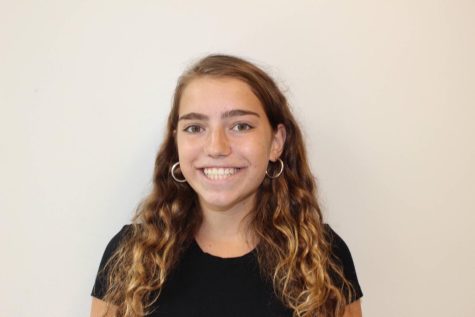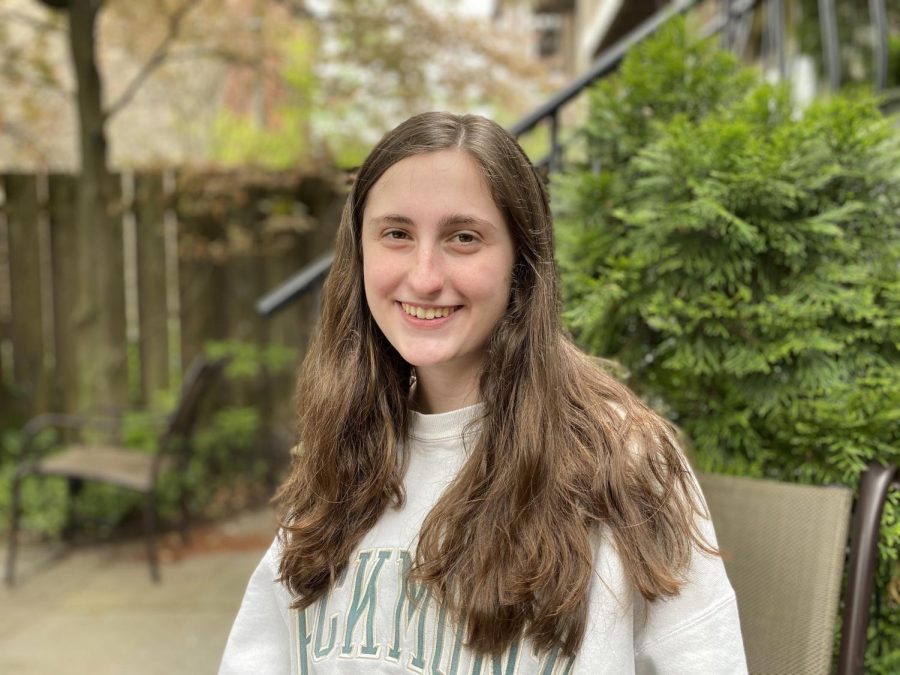Making History by Writing History
Senior Molly Taylor Advances to State History Competition
Photo credit: Anna Fuder
Senior Molly Taylor recently advanced to the statewide Illinois History Day competition after writing an essay about the 1937 Exposition Internationale.
The German Pavilion and the Russian Pavilion oppose each other. In between the two pavilions stands the glistening Eiffel Tower. These two countries are amongst the 44 other countries represented at the 1937 Paris International Exposition. The countries are supposed to be at the World Fair as an act of unity, but that does not happen.
Senior Molly Taylor took a particular interest in the 1937 Paris International Exposition, and wrote an essay about it, which was later entered in the National History Fair competition.
First semester, Taylor decided to pursue an independent study about world’s fairs. “I did not really know which world’s fairs I would focus on, specifically, going into it, but I just read about a bunch,” Taylor said.
When Taylor came across the 1937 World’s Fair, she was immediately intrigued and wanted to focus more on it. “The more I read about 1937, the more it stood out to me as something that would be very interesting to learn about, and how it sort of failed as a World Fair,” Taylor said. Taylor wanted the culminating project of her independent study to be an essay.
Taylor’s essay explores “how and why the 1937 Paris Exposition Internationale failed to build bridges between participating countries instead strengthened ideological divisions and contributed to the outbreak of World War II.” She goes into depth about the “competing dynamics of nationalism and international cooperation at the fair, revealing the historic significance of this failure to break barriers.”
In Taylor’s introduction, she sets the stage as to how world’s fairs usually play out. She also highlights what other majors historical events are happening at the time and connects them to the relatively small world’s fair. “She has taken a very small moment in time which is the 1937 World’s Fair,” Upper School history teacher Susan Elliott said. “It was a time in history when Spain was involved in a civil war, Germany had moved into the Rhineland, the Soviet Union had launched its whole Bolshevik Revolution and had started its totalitarian regime, and all of these big things were going on outside of this small, little world’s fair. She takes what was happening at the World’s Fair, and she connects it to all of these other events outside of Paris, which is a genius way to approach history to show how one small event really reflects much bigger trends and bigger events that are coming.”
Taylor also highlights how the events of the Paris International Exposition was a preview of World War II. “And how interesting that was—the fact that each of their exhibits, in a sense, basically sets the stage for World War II, meaning the exhibits showed their unwillingness or naiveté as to how different they are from the rest of the world,” Upper School history teacher Andrew Bigelow said.
The essay also called attention to some of the relationships foreshadowed in World War II. “The reason the 1937 exposition is so interesting is because it actually showed the competition between Germany and the Soviet Union, which is sort of representative of the tensions that went into World War II,” Taylor said.
In order to put together her essay, Taylor needed to compile multitudinous sources. She used a mix of primary and secondary sources. “A lot of the secondary sources were from really long academic papers,” Taylor said. Taylor struggled to pick through the academic papers to find relevant information because they were so much more complicated and in depth than sources she usually reads for in-school papers.
For primary sources, Taylor looked through old newspaper archives from 1937. “It was really cool, but it was just sort of hard to find specific articles that were relevant to what I was talking about and how I could work them into my writing,” Taylor said.
Bigelow is Taylor’s regular school advisor, so, out of curiosity, he would occasionally check in with Elliott to see how the essay was progressing. “Ms. Elliott said that, to no surprise, Molly was doing some solid research and finding out some pretty incredible history about the World’s Fair at the brink of World War II,” Bigelow said.
The faculty advisor for Taylor’s independent study was Elliott. “Throughout the independent study, Ms. Elliott provided me with guidance and edits to make the essay better,” Taylor said.
Taylor entered her essay in the National History Day competition. National History Day is a non-profit organization that hosts national, annual contests. The entries for the National History Day contest range from essays, exhibits, performances, documentaries, or websites. To get to nationals for this contest, you need to go through regional and state level competitions. The Chicago Metro History Fair is the regional competition that Taylor was a part of and then she was a part of the statewide conference, Illinois History Day. She did not advance to Nationals, but only two out of around 30 essays were chosen, and she did not have high expectations. “I don’t have any expectations for that because it gets really competitive from state to nationals, but it’s just a really cool opportunity for students to share their work,” Taylor said.
Every year, the contest has a theme. “This year the theme was breaking barriers, and when I read her thesis I was like, ‘Wow this really works for this competition,’” Elliott said, “She kind of changed her topic and theme just so she would fit in, and do well in the competition, and it worked.”
Taylor was thankful that Elliott introduced the competition to her. “I did not know about the competition before, and I am really thankful that she sort of pushed me to do that because I probably would not have wanted to put myself out there without that help, but it is a really cool program, and I am glad I did it,” Taylor said.
Bigelow is also really proud of Taylor for entering her essay in a contest. “The thing is every year we try and try to get kids to sign up to enter their essays in these contests, and we rarely get anyone to do that,” Bigelow said. “I am so glad that Molly took the initiative to do so, and as a result she’s a winner.”
Although Elliott knew Taylor really well going into her independent study, a new trait that she discovered about Taylor was that she is nimble. “She was like that’s not working, let’s drop this and go to this. It was really impressive just from the standpoint of being a scholar, of just being willing to apply herself to a new challenge all the time,” Elliott said.
“I talk about France, the Soviet Union, and Germany in my essay, and how their focus on advancing their national agendas instead of buying into the theme of unity that should be present at a World’s Fair,” Taylor said, “I think my takeaway is how nationalism can hinder international cooperation. At this time countries were so intent on pushing their national agendas instead of working with other countries, so the Fair was kind of doomed from the beginning and it was exploited by most of the countries.”








